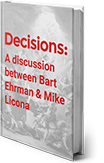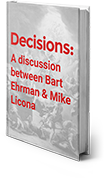An Assessment of the Present State of Historical Jesus Studies
“An Assessment of the Present State of Historical Jesus Research” is a popular level summary in a chapter included in a book by Sean McDowell, A New Kind of Apologist (Eugene, OR: Harvest House Publishers, 2016), Used by Permission
Michael Licona
A few years ago, I boarded a plane for a very long flight. I had a new book I had saved for the trip and was very much looking forward to reading it. Shortly after I took my seat, an elderly man, probably in his eighties, took his seat next to me. I smiled thinking, He’s going to fall asleep and I’m going to get in a lot of reading.
I was mistaken. Just after I began reading, my fellow passenger leaned over and looked very deliberately at the pages of my book. I smiled and showed him the cover. It was a book on the historicity of the resurrection of Jesus. He chuckled and said, “Well, I guess we don’t have to think seriously about that, since it has now been proven that Jesus never even existed!” He then sat up straight, as though our conversation had ended and now it was time to find something else to do. Hit and run? Not a chance, my new friend.
“Why do you think Jesus never existed?” I asked. This led to a short conversation on Jesus’s existence. It did not take long for him to concede that Jesus had, in fact, existed. But he maintained that “resurrections are impossible. There is no evidence for the resurrection of Jesus and it certainly could never be proved.” Perhaps you have had a similar discussion with someone and wished you had known how to reply. In what follows, I am going to discuss three key areas that will both inform and equip you to engage in intelligent discussions about Jesus with others.
Current State of Historical Jesus Studies
Our first matter is to define what is meant by the “historical Jesus.” Although scholars have not agreed on a definition, most would at least be satisfied with the following definition as a means to enter a discussion: When the data has been sifted, sorted, and assessed, the historical Jesus is the Jesus historians can prove with reasonable certainty and apart from faith.
It is important to observe that the historical Jesus is not the real Jesus who walked and taught in Judea and Galilee, but is the Jesus known through the results of historical investigation. The real Jesus was much more than the historical Jesus, just as a corpse in a grave was once much more than the minimal information described on the tombstone. And then there is the Jesus in the Gospels. This third Jesus is also a partial representative of the real Jesus who had many more elements to his personality and many more things that he said and did than could ever be reported in a Gospel with a length of less than twenty-five thousand words.
It is very important to understand these distinctions and many often fail here. In theory, these three Jesuses are not necessarily in conflict. For example, if historical investigation were some day to prove that the real Jesus did not claim to be the Son of God, the real Jesus and the historical Jesus would be in conflict with the Jesus in the Gospels, since the Jesus in the Gospels claimed to be the Son of God. On the other hand, the inability of historical investigation to determine whether Jesus was born of a virgin does not place the historical Jesus in conflict with the Jesus in the Gospels or the real Jesus, since the former will always be an incomplete figure. Accordingly, if historians cannot prove Jesus performed Event X, it is a misstep to conclude on that basis that it did not occur. To do so would be quite naive, since numerous events that actually occurred in the distant past cannot be verified.
How do historians arrive at conclusions regarding Jesus? There are several approaches and various tools used within each approach. The most common approach at present is to recognize that Jesus was a Jewish itinerant preacher who lived in first-century Palestine in a culture that was both Jewish and Greco-Roman. This provides historians with a background knowledge that helps them obtain a more accurate understanding of what Jesus taught and the impact it may have had on those who heard him. They then apply what are referred to as criteria of authenticity to the words and deeds of Jesus as preserved in the Gospels. These criteria reflect commonsense principles. If two or more sources that are independent of one another provide similar reports of the same event, we can have more confidence that the event had occurred than if only one source had reported it. This is called the criterion of multiple attestation. For example, the Gospel of Mark and Paul’s letters are independent of one another. So, when both report that Jesus was buried, we have multiple attestation of the event.
If a source that is unsympathetic or even hostile toward the Christian faith provides a report that agrees with the Christian reports, we can have more confidence that the event had occurred, since the unsympathetic or hostile source would not have the bias carried by the authors of the Christian reports. This is called the criterion of unsympathetic sources. For example, Tacitus referred to Christianity as an evil and mischievous superstition (Annals 15.44). This identifies him as an unsympathetic source. So, when he reports Jesus’s execution by Pontius Pilate, a report entirely compatible with what we find in the Gospels, historians can have more confidence that the event had occurred.
If a report in the Gospels provides data that would have been embarrassing to the early Christian movement, we can have more confidence that the event had occurred, since it is unlikely that the author would have invented content likely to detract from the cause for which he wrote. This is called the criterion of embarrassment. For example, Mark reports that Peter rebuked Jesus and that Jesus in turn rebuked Peter, calling him “Satan” (Mark 8:31-33). Since Peter was a leader of the Jerusalem church, it seems unlikely that the early Christians would have invented and preserved a tradition that casts him in such an unfavorable manner.
Historians prefer to have reports that are from eyewitnesses or from a source whose report was written close to the event it purports to describe. This is called the criterion of early attestation. For example, almost all scholars agree that Paul has preserved an oral tradition in 1 Corinthians 15:3-7 that goes back to the earliest days of the Christian church and that the content of these verses, although not necessarily the creedal form in which the content appears, very probably goes back to the Jerusalem apostles.
It would be nice if historians could climb into a time machine, return to the past, and verify their conclusions. Since that is not possible, historians can establish matters with only varying degrees of certainty. And it is entirely possible that a lack of data could lead historians to arrive at a false conclusion. This is not only the state of affairs when historians investigate biblical events but also with every other purported event in antiquity. Accordingly, the fulfillment of one or more of the criteria of authenticity in relation to specific reports about Jesus may be said to establish their authenticity with “reasonable” but not “absolute” certainty.
Historians who investigate nonreligious matters have strenuously debated the nature of history for several decades. Understanding the many challenges to knowing the past faced by historians, some have claimed that the past cannot be known and that historians merely create their own narratives of the past based on their subjective interpretations of the data. These are known as postmodern historians. Although the debate concerning the nature of history continues, the majority of historians have come to reject postmodern approaches to history and embrace realism, the view that the past can be known to a degree. Of course, historical descriptions of the past will never be exhaustive, will vary in their accuracy, and can be established with only varying degrees of certainty.
Therefore, when speaking of Jesus, it is unreasonable to demand absolute certainty. This is important because many of the skeptics we encounter outside the academic world, and even some skeptics within it, have an approach that, in essence, says, “As long as there is an alternate explanation to the biblical account that cannot be absolutely disproved, the biblical account should not be taken seriously.” Such an approach suggests those holding this view have a sophomoric understanding of how the practice of history works. A competent historian embraces what he or she concludes is the most probable explanation of the available data, since there is little of the distant past that can be established with such certainty that no room remains for an extremely unlikely alternative.
The Jesus Mythers
During the past twenty years or so, a number of books and articles have appeared on the Internet arguing that Jesus is a myth who never existed. Viewing the biographical information of their authors reveals that only a handful have any academic credentials. Unfortunately, most people reading the literature written by “mythers” (as they are commonly referred to) are not accustomed to critical thinking by comparing sources. For them, Earl Doherty and Dee Murdock (aka Acharya S) are as credible as John Meier and N.T. Wright. Yet they are unaware that neither Doherty nor Murdock ever went beyond earning a bachelor’s degree while Meier and Wright earned doctorates in relevant fields and teach New Testament studies at prestigious universities.
I am not claiming the lack of academic credentials on the part of Doherty and Murdock prohibits them from having good arguments and, therefore, they should be ignored. However, it is true that they do not have the training and experience in the proper fields. As a result, they often make egregious errors and silly proposals that sound credible only to the naive.??1 Mythers are often guilty of twisting data, providing false claims, appealing to other sources who are also not scholars, requiring an unreasonable burden of proof before acknowledging the existence of Jesus while being unaware that the scenarios they have proposed in order to address the data border on unbridled fantasy. Readers should understand that publishing on the World Wide Web does not make one a world-class scholar, since the only credential one must have to publish on the Internet is to breathe.
It is noteworthy that one could count on one hand all the scholars in the fields of history and biblical studies who have been persuaded by the arguments of mythers. This is not because the majority of historians and biblical scholars are Christians (I seriously doubt that is the case). It is also noteworthy that even some atheist and agnostic scholars have blasted mythers for their poor arguments and treatment of the data.??2 Scholars simply refuse to give them much attention and regard them to be as absurd as holocaust deniers.
Discussing the Historical Jesus with Others
With the advent of the Internet in the nineties, an explosion of information became available to the public. Christians are far more likely to hear arguments from their skeptical family members, colleagues at work, and neighbors that are more sophisticated than what they may have heard before the Internet. Moreover, our culture has changed. People are easily offended and many regard truth as relative. Everyone has their own truth and thinks it is morally wrong to offend others by telling them you think they are mistaken.
The apostle Paul adjusted his approach to relate better to his particular audience.??3 We should do no less. We must be more careful than ever to be winsome in our interactions with nonbelievers. We can be respectful of those we disagree with and make an effort to listen to them while they present their views in the same manner we would like for them to listen to us while we present ours. We should not overstate our case but temper it. Instead of saying “The historical evidence proves that Jesus rose from the dead,” say “The historical evidence strongly suggests Jesus rose from the dead.” Instead of saying, “I know that I know Christianity is true,” say “In view of the evidence I’ve examined as well as the answers to prayer I have personally witnessed, I’m convinced Christianity is true.”
Remember the words of the apostles Peter and Paul. Peter wrote, “But set apart Christ as Lord in your hearts, always prepared to give a defense to everyone who asks you to give an account concerning the hope in you” (1 Peter 3:15, author’s translation). Paul similarly wrote, “Your speech should always be gracious, seasoned with salt, so that you may know how to answer each person” (Colossians 4:6, author’s translation).
It is important to recognize that presenting good arguments to a skeptic will not ensure he or she will be convinced by them. Their objections to following Christ may be intellectual (e.g., they are not persuaded by the evidence), emotional (e.g., their Muslim or Jewish family would disown them or they had a poor experience with one or more Christians or their father), or volitional (e.g., they do not want to believe because of pride or it may require them to alter their behavior).
It is their responsibility to make a proper decision. It is our responsibility to share the message of hope through Christ “with gentleness and respect” and “with grace,” as Peter and Paul taught. The gospel message is already offensive to some. We need not make it more offensive by presenting it in a manner that lacks gentleness, respect, and grace. When we combine more knowledge with a heart that deeply cares for our nonbelieving friends, we will be pleasantly surprised to find ourselves engaged in dialogues that are far more enjoyable and effective than we may ever have imagined.
Mike Licona, PhD, is associate professor of theology at Houston Baptist University. He is the author of numerous books, including The Resurrection of Jesus, Paul Meets Muhammad, and coauthor with Gary Habermas of The Case for the Resurrection of Jesus. Mike has spoken on more than seventy university campuses and has appeared on dozens of radio and television programs. His website is www.risenjesus.com.
Taken from A New Kind of Apologist
Copyright © 2016 Sean McDowell
Published by Harvest House Publishers
Eugene, Oregon 97402
www.harvesthousepublishers.com
Used by Permission






